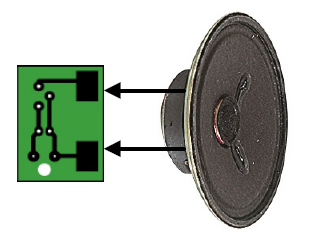Did it ever
occur to you that an array of white LEDs can be used as a small lamp for the
living room? If not, read on. LED lamps are available ready-made, look exactly
the same as standard halogen lamps and can be fitted in a standard 230-V light
fitting. We opened one, and as expected, a capacitor has been used to drop the
voltage from 230 V to the voltage suitable for the LEDs. This method is cheaper
and smaller compared to using a transformer. The lamp uses only 1 watt and
therefore also gives off less light than, say, a 20 W halogen lamp. The light
is also somewhat bluer. The circuit operates in the following manner: C1
behaves as a voltage dropping ‘resistor’ and ensures that the current is not
too high (about 12 mA).

The bridge
rectifier turns the AC voltage into a DC voltage. LEDs can only operate from a
DC voltage. They will even fail when the negative voltage is greater then 5 V.
The electrolytic capacitor has a double function: it ensures that there is
sufficient voltage to light the LEDs when the mains voltage is less than the
forward voltage of the LEDs and it takes care of the inrush current peak that
occurs when the mains is switched on. This current pulse could otherwise damage
the LEDs. Then there is the 560-ohm resistor, it ensures that the current
through the LED is more constant and therefore the light output is more uniform.

There is a
voltage drop of 6.7 V across the 560-Ω resistor, that is, 12 mA flows through
the LEDs. This is a safe value. The total voltage drop across the LEDs is
therefore 15 LEDs times 3 V or about 45 V. The voltage across the electrolytic
capacitor is a little more than 52V. To understand how C1 functions, we can
calculate the impedance (that is, resistance to AC voltage) as follows:
1/(2π·f·C), or: 1/ (2·3.14·50·220·10-9)= 14k4. When we multiply this with 12
mA, we get a voltage drop across the capacitor of 173 V. This works quite well,
since the 173-V capacitor voltage plus the 52-V LED voltage equals 225 V. Close
enough to the mains voltage, which is officially 230 V.
Mains Powered White LED Lamp
Circuit Diagram
Moreover, the
latter calculation is not very accurate because the mains voltage is in
practice not quite sinusoidal. Furthermore, the mains voltage from which 50-V
DC has been removed is far from sinusoidal. Finally, if you need lots of white
LEDs then it is worth considering buying one of these lamps and smashing the
bulb with a hammer (with a cloth or bag around the bulb to prevent flying
glass!) and salvaging the LEDs from it. This can be much cheaper than buying
individual LEDs…






























